After a relaxing few days in the small, delightful town of Arcos de la Frontera, we hopped on a bus back to Jerez de la Frontera and then on to Sevilla, the gateway to the New World in the 16th century. The explorers Amerigo Vespucci and Ferdinand Magellan sailed from its river harbor on their way to discovering new trade routes and huge sources of gold, silver and tobacco. In the 17th century, the city was Spain's largest and wealthiest city and local artists Diego Velasquez and Bartolme Murillo made it a cultural center. Sevilla's Golden Age and also its New World riches ended when the harbor silted up and the Spanish empire crumbled. However, Sevilla was a major stop on the 19th century European Romantic Grand Tour. Steven and I were looking forward to its being our stomping ground for the next several days.
The palace, built between the 15th and 16th centuries, is the current Sevilla residence of Carlos Fitz James Stuart, the 19th Duke of Alba. Stuart was responsible for turning part of Las Duenas into a museum so Sevillians, Andalusians and others could also view the beautiful palace and its treasures beginning in March of 2016. What a grand entrance it was, complete with parallel rows of orange trees and a pathway lined with blooming poinsettias.
The palace, considered to be one of the finest examples of noble architecture in Spain, was originally the palatial mansion of the Pineda family whose members played an important role in the War of Granada. When a family member was imprisoned by the Moors, the family was forced to pay an enormous ransom. That and other economic problems forced the family to sell the home to someone whose daughter married the 6th Duke of Alba. In 1612, the palace became part of the House of Alba estate.
Surrounding the home was the magnificent Central Courtyard which had seen the most important family and social events.
How adorable seeing the chubby angels or Cupids.
The riding saddle in a room off the entrance hall was from Morocco. The 19th century saddle implements in the cabinets had belonged to Napoleon III.
Our eyes were drawn to the painting of St. Catherine of Siena among Saints by the 15th century Italian painter, Neri di Bicci.
The monument honored Lola Flores, a Spanish singer, dancer and actress who died in 1995.
Our stroll toward Palacio de Las Duenas, one of the city's great historical attractions, took us past the Alcazar, originally the 10th century palace built for the governors of the Moorish state. Keep this place in mind as we visited it a couple of days later.
These other places caught my eye on our walk to Duenas Palace, even though I can't remember what they were!
The exterior of the palace looked so unassuming, we wondered whether a visit there would really be worth all the rave reviews on Trip Advisor. It would be interesting to find out and see what we thought for ourselves!
Janina: You and Pat would have loved seeing the the flowering bougainvillea that provided the most wonderful hint of color next to the entrance. Las Duenas' name was derived from the now disappeared monastery (or convent as we would refer to it) of Santa Maria de las Duenas. In 1248 the nuns who lived there served the queens and wives of the kings of Castile.
A home's stables were one of the most important features in old family homes in Sevilla, not only because a horse carriage was a sign of wealth, but because it provided the only means to move around the city. The members of the House of Alba always considered carriages and the animals who pulled them of great importance and even still use them today in the most important social events such as the traditional opening parade at the Sevilla Fair in April, a highlight since 1846.
The sign depicted the duke's crown above letters signifying the House of Alba. Other mementos in the stable had belonged to the wife of Napoleon III.
The cotton cloth under the saddle in the tack room was adorned with tassels.
I learned that gardens and courtyards were very characteristic of Sevillian buildings as they cooled off the house when the suffocating heat starts to rise in summer, but were also a main decorative element of the household. The most famous that had been preserved was known as this Lemon Tree Garden.
I loved wandering through the garden as I have loved baking with lemons for many decades! I wish I could have captured the scent of the garden's lovely lemons for you.
Delightful water features abounded in the palace gardens which looked so inviting.
The white Carrara marble pillars were topped by coats of arms with the main lineages of the House of Alba.
I was surprised to see such glorious Flemish tapestries in the courtyard as I'd have thought they might get damaged exposed to the elements.
Imagine living in a home with such an appealing Mudejar ceiling interspersed with such lovely tile work!
The central fountain had exquisite 15th century tiles.
The courtyard's 16th century frescoes had been whitewashed over to prevent the spread of epidemics in urban areas.
It was wonderful eyeing the 15th and 16th century frescoes that had been discovered under layers of whitewash.
Through the wrought-iron doorway, we had a marvelous view of the palace's grand entrance we'd walked through a bit earlier.
Walking into the entrance hall, it was immediately apparent how important bullfighting had been to the House of Alba and to the residents of Sevilla where the sport or activity was still considered politically correct. The series of eight 19th century paintings depicted the tientas, the testing of a bull's bravery before the bullfight.
The room on the other side of the hall contained a stained glass window with a coat of arms from the House of Berwick-Alba.
The Olive Oil Courtyard was named because of the large earthenware oil jars that were kept there in days gone by for traditional agricultural activities and to store animals and crops. The floor was decorated with a fish spine motif. The huge jars with their flower motifs were remarkably well preserved.
The museum-quality busts were left out for all to admire; I was surprised that there was so little security in the courtyards and also at the total absence of signs admonishing people to be careful around the priceless antiques.
The white marble sculpture of Venus Sitting on a Panther was created in the 19th century.
Here was yet another courtyard!
The Salon had a huge collection of 17th century paintings, sculptures and tapestries and another coffered ceiling. The terracotta bust was of the 19th Duke of Alba, the current resident, when he was a young man in 1962.
The Reading Room, like everything else in the palace, was simply divine. However, with every inch of wall space covered, I would have had a tough time relaxing in that room or any other room we'd seen so far with so many curios taking up every inch of space.
It looked like the only available spot one could just comfortably 'hang out in' was on the cushions on the floor!
The Flamenco Room was a riot of color but I just wondered where on earth the Duke or his family could spend their time as it all seemed so museum-like. Since little girls in Sevilla still dream of growing up to become flamenco dancers, this room may have been the bees' knees for them! The middle of the floor was set aside for impromptu flamenco dances.
I bet you think I was kidding about the lack of available wall space! Apparently, the Duchess was an amateur painter and also avid art collector in addition to loving flamenco dances.
The Palace's Ante Chapel was very important socially since it was the meeting place for family and friends in religious celebrations that take place in the Palace chapel. It had Louis XV furniture and a series of doors from La Escorial, the historical residence of the kings of Spain we'd visited near Madrid.
The much calmer Ballroom was also called the Gypsy Salon because the main object in it was a sculpture of a flamenco dancer. The room was described as being the perfect place to receive friends or celebrate social events with important Spanish and international celebrities.
One entire wall in the elegant room was taken up by the mammoth 16th century wool, silk and gold tapestry titled Mythological Scene: Mercury Falls in Love with Herse.
It was pretty neat seeing the family photos of Grace Kelly, Prince Rainier and Jackie Kennedy who had spent time at the palace! Other important figures had also walked these floors: Queen Sofia of Spain, the British King Edward VIII of England and his American wife, Wallis Simpson.
One of the things I 'd loved about our extended trip to Spain was the gorgeous tile work in so many places we were lucky enough to visit. The palace stairway was no exception.
Coming down from the palace's private quarters were two young men - I wondered if they were family, friends or servants!
Steven and I were so glad we chose to tour the palace with its interesting decor and memorabilia, and beautiful and charming gardens. I felt we really got a sense of what it was like for people of wealth and social status living in Sevilla.
The garage opposite the palace sported this God Save the Duchess sign - I don't know if they preferred the Duchess to the Duke or he was no longer alive.
It was fun peeking through the elegantly tiled entrance way and iron gates of another home and seeing the decorated Christmas tree inside its courtyard. It brought me back to my youth and going to see Santa at the local shopping center!
The tower of the Santa Angel de la Cruz Church looked especially appealing when the sun caught it in the late afternoon.
We couldn't help but smile when we happened on Metropol Parasol, a wooden structure made of Finnish birch that was located in the old quarter of Seville. Designed by a German architect, it was completed in April 2011 and claims to be the largest wooden structure in the world. When I checked it out on wikipedia, I read that the structure consisted of six parasols in the form of giant mushrooms whose design was inspired by the vaults in the Cathedral of Seville and the ficus trees in a nearby park.
Steven has always loved window shopping so gazing at the treats in the La Campana candy and ice cream shop was very inviting.
More interesting sights on our walk back to our hotel:
Our hotel was in an ideal location in Sevilla - close to all the sights we wanted to see, restaurants, a fair in the big square just out front, and also close to a place we hadn't wanted to see, the local police station, but that's a story for a later post on Sevilla!
One of my weaknesses has always been chocolate raised donuts but never had I seen ones that must have weighed close to a pound each and probably would have added two inches to my hips!
Next post: Basilica de la Macarena - nothing to do with the dance of the same name, I'm sorry to say!
Posted on another snowy and then gloriously sunny day from our home in Littleton, Colorado.





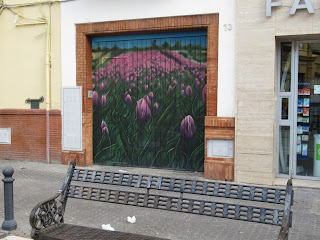











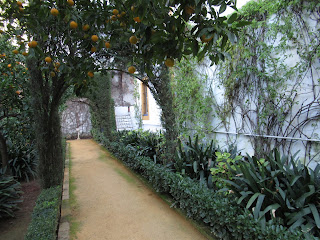








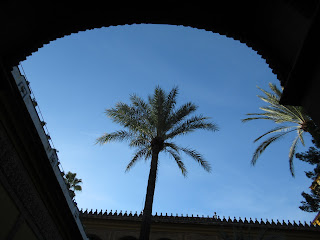



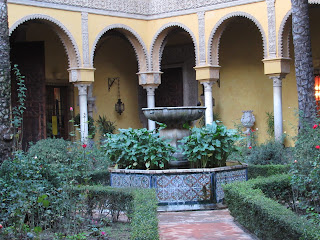



















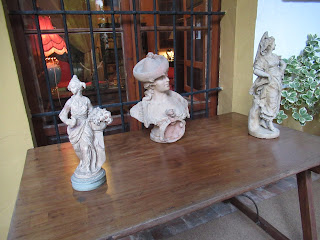











































Venus Sitting on a Panther... What was she thinking? Janina
ReplyDeleteArtistic license, I'm guessing!
Delete